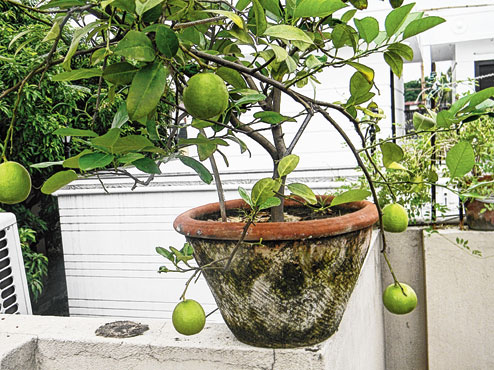S.K. Maiti, patron of Bidhannagar Horticultural Society and a civil engineer residing in FC Block, offers guidance on choosing fruit trees to suit Salt Lake’s soil and climate

with roundish fruits. (Below) An oblong-shaped Gandharaj
In this concluding edition on citrus fruits we shall discuss Gandharaj Lebu. Incidentally, this is one of the most commonly grown tress in Salt Lake, and residents who are fond of gardening grow plenty of them in containers.
The evergreen shrub Gandharaj is a cultivar of the Lemon (Citrus limon). It is a highly flavoured fruit and generally produces only one crop annually over an extended period and the fruit tends to drop when ripe. Lemons are cultivated to a limited extent in India but it is a good sign that the area under lemon cultivation is increasing day by day.
Growing a Lemon tree in a container is not that difficult as long as their basic needs are provided. Lemons are more sensitive to cold than other citrus trees and it requires full sunlight for adequate growth.
While Lemon trees can tolerate a range of soil, it prefers well-drained loamy soil enriched by well-decomposed compost, Farm Yard Manure and Poultry compost. In containers, it reaches up to a height of 2m, though it is a bushy type of plant. Extra nitrogen of 250g and potassium 125g per plant are required every year for its growth.
This should be applied in two doses during March and September and should be applied in the root zone. If the tree becomes very bushy, a little pruning should be done. Else there is a chance of the tree being uprooted during windstorms, especially when it is grown on the terrace.

Lemon is mostly propagated by hard wood stem cuttings, air layerings and also through seed. February and March are suitable for taking cuttings and July for transplantation. Seedlings are usually slow to bear.
Most Lemon cultivars produce seeded fruits but there is a variety called Pant Lemon-1. Fruits of the Lemon are commonly oblong in shape, but Pant Lemon-1 produces almost round and juicy fruits throughout the year. The fruits are almost seedless too. They take five to eight months from fruit setting to ripening. On ripening, fruits become yellow but in some varieties they remain green. The fruits should always be plucked in the afternoon because the temperature is usually less than in the morning. Since it is cooler at night, the plucked fruits will adjust better in storage thereafter.
Lemon juice and its rinds are used for various culinary purposes.
Before concluding, I would summarise a few points for efficient cultivation of citrus fruits:
Planting material (the tree) in citrus plays a major role in determining the quality of produce. Select good quality disease-free and pest-free planting material and seeds to boost productivity.
Select cutting or seedling of a six to nine month old, straight and single stem of height not less than 30 to 40cm and diameter 0.5cm. It should be well-rooted and healthy with green leaves.
For the first few years feed citrus trees with balanced fertiliser that has high nitrogen and medium potassium level. Apply fertiliser in two to three doses at regular interval.
Double the quantity of fertiliser after five years. A mulch helps retain moisture. Apply fertiliser when the trees are in active growth. The occasional dose of micronutrients helps too.
Water thoroughly in dry weather, particularly when flowers and fruits are developing. Remove suckers promptly.
These are branches that emerge from the base and suck all the nutrients. Keep the plants pest and disease-free.
If you use a suitable soil mix, feed the plant regularly, water it and keep a watchful eye for signs of pest and diseases, you should be able to grow all sorts of citrus plants successfully.
So pick up a spade, head to the garden and plant a citrus sapling today. Grow Mosambi and Gandharaj in containers and place them in the terrace or patio. And plant Kagzis and Batabis in the garden as a symbol of beauty, for passersby to stop and stare at.
Concluded











